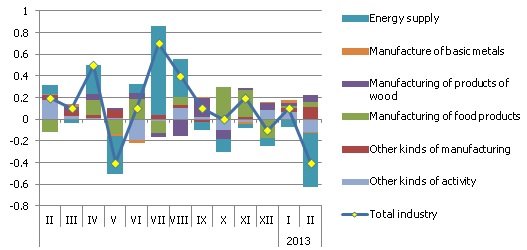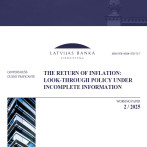Producer prices drop, supply side pressure on prices still low
In February 2013, the producer prices on production sold domestically dropped, and the drop was sufficient (-0.4%), to bring down the total producer price index (by 0.2%). As was expected, such price dynamics was primarily determined by the energy producing branches (which primarily operate in the domestic market), in all likelihood, under the impact of the drop in average resource price in previous periods. As a result, the rate of the annual rise in producer prices has also dropped to 1.7%, the lowest level since April 2010. In the first months of this year, the difference between the annual rises in producer price index for the production slanted for the domestic and external markets has contracted substantially year-on-year and has become negative. That helps to augment the competitiveness of producer costs in the domestic market.
Contribution of main kinds of economic activity to the m-o-m growth of PPI for production sold on domestic market (%).

Source: CSB
At the beginning of the year, similar to the fourth quarter of 2012, no pressure of labour costs has been observed in manufacturing, where producer prices tend to rise most. The fastest rise in January-February of this year compared to the fourth quarter of 2012 was observed in such branches as the manufacturing of leather and its products, printing and publishing and reproduction of recording, metal manufacturing and the production of other equipment, mechanism and work machinery, which relatively rarely registers lack of labour as an obstacle to growth. The data of a business survey published by the European Commission indicate that in 10 out of 33 manufacturing branches, there has been an increase in the proportion of those entrepreneurs who mention lack of labour as a factor limiting production. However, independently of an increase or a decrease in that proportion, the percentage of such answers is at least 10% in only four out of 33 branches (a year ago there were also four, whereas in the fourth quarter of 2012 there were eight such branches of manufacturing).
Moderate changes in producer prices in the coming months will be determined both by external factors (prices of oil products have dropped in March) and some domestic factors mentioned earlier (e.g., the expected impact of thermal energy being produced in the new bio-fuel stations in Riga and the transition to thermal energy production in cogeneration in Rēzekne). The trend in producer prices can be negatively (toward rises) affected by the appreciation of electrical energy supply to industrial producers as a result of an increase in the mandatory procurement component (MPC). Even though the new MPC will appear on bills as early as of April, its impact on the prices of particular products will depend on the proportion of costs of electrical energy in the structure of production costs and their further impact on consumer prices on whether or not the manufacturer is active in the domestic market. This impact may also be gradual and express itself over time depending on the length of time the supply contracts signed by an enterprise are in effect, on the possibilities of absorbing the increases in costs and of printing the new price lists etc.
Textual error
«… …»






